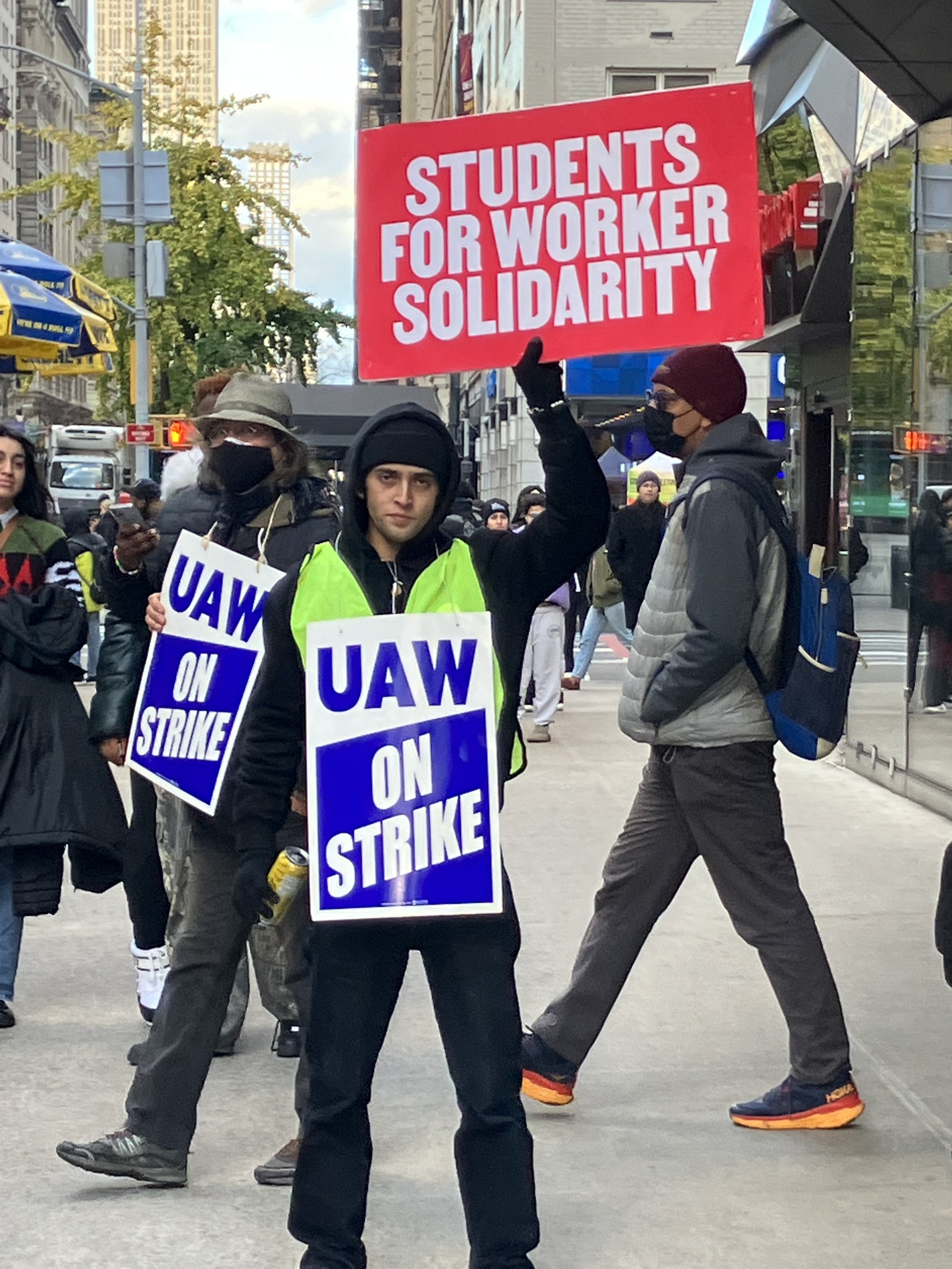In the Fight Against The Big Three…the UAW Can Win Even Bigger - For All of Us
New School students rallied in strong support of ACT-UAW Local 7902 adjunct professors last winter. The UAW’s contract with the Big Three automobile manufacturers expires on Sept. 14. Photo by Joe Maniscalco
By Joe Maniscalco
Let’s be honest, wherever you’re working today — behind a computer, up on an I-beam, in front of classroom or the back of a delivery bike — how much time have you actually spent thinking about auto workers and their impending strike against the Big Three automobile manufacturers?
Not much or not at all, right?
Sure, you work for a living, so you wish the United Auto Workers [UAW] all the best in their ongoing contract negotiations. You might even know that their current contract with Ford, GM and Stellantis expires in a week, and as things now stand the likelihood of bringing home a just settlement without a strike does not look good at all.
But no matter what we do for a living, we should all care a whole heckuva lot more and pay much closer attention to what is happening between UAW President Shawn Fain’s negotiating team and the auto industry bosses — because this labor struggle is big and has the potential to change all of our lives.
The current UAW contract negotiations involve some 150,000 members working for Ford, GM and Stellantis. Overall, there are some 400,000 active UAW workers in a variety of occupations, as well as another 580,000 retired members located across the United States and Canada.
What members are demanding is a game-changer. We’re talking about terraforming-level stuff, taking the barren labor landscape of the last fifty years, and bringing forth orange groves and crystal streams.
UAW members are demanding the fundamentals, of course. They want big double-digit wage increases and cost of living adjustments, too. Having raked in more than $250 billion over the last decade — $21 billion in the first six months of this year alone — the Big Three can surely afford it, the union argues.
The past 20 years has also seen the Big Three automobile barons shut down 65 of their manufacturing plants, so the UAW is also demanding the right to strike against any new plant closures, as well as an end to the two-tier pay system — the perniciously crafty way bosses across all sectors of the economy use to maximize profits and undermine union solidarity.
In addition to all that, however, the UAW is also threatening to strike for the return of defined pension and retiree medical benefits — and more paid time off.
Calls for a return to a secure and dignified retirement get a lot of lip service within the labor movement these days, and sound particularly hollow given the number of union leaders eager to sell out municipal retirees in New York City and other places around the country to privatized Medicare Advantage plans.
But here’s a chance to help make all those calls for a secure and dignified retirement real.
And how much time off? The UAW is advocating for a four-day, 32-hour workweek.
If that sounds far-fetched, remember “eight hours of work, eight hours of rest, and eight hours to do what we will” was a concept people in this country also had to first wrap their heads around before the eight-hour workday we all know and now loathe was established.
The 32-hour, four-day workweek can be established today — and not just in the automotive industry, but for everybody. The gains that the UAW wins, should members continue the level of militancy they have demonstrated thus far, will not be restricted to just one industry alone. They’ll cascade across every workplace in the nation.
The bosses already realize this, even if all us workers do not.
Some bosses, like those involved in the 4 Day Week Global project, are actually — astonishingly — campaigning for the societal time shift.
At a 4 Day Week Global webinar held earlier this summer, Jon Leland, chief strategy officer for Kickstarter, enthusiastically touted the many benefits of abandoning the old 40-hour workweek and establishing a new 32-hour workweek that promises to contribute to a more resilient and “better balanced society.”
“More business leaders are waking up and realizing this does work,” Leland said.
Congress Member Mark Takano [D-Calif.], reintroduced the still-pending “Thirty-Two-Hour Workweek Act” back in March. At the same webinar, he pointed out how “[Artificial Intelligence] is going to force us to have this conversation.”
“If it’s true less work is required,” the California representative said, “and all profit goes to capital…who’s going to buy stuff?”
There’s so much at stake here at this very moment. That’s why workers everywhere — no matter how we earn our living — need to get behind the UAW to help make sure they win big.
For everyone.

